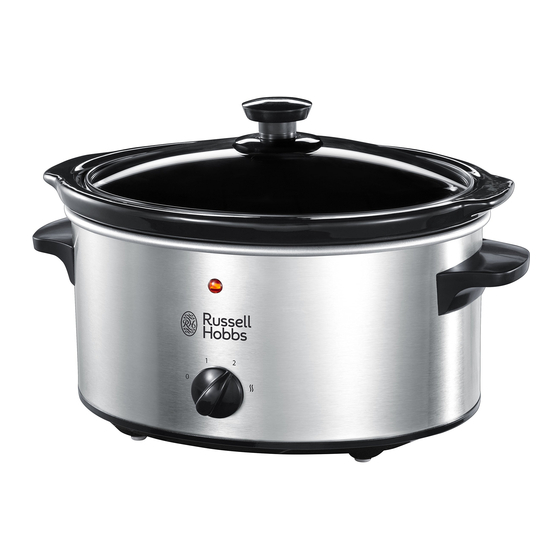Summary of Contents for Russell Hobbs 23200
- Page 1 23200 I www.russellhobbs.com Register online for an EXTRA year guarantee Visit www.russellhobbs.co.uk/productregister/ You must register within 28 days of purchase...
-
Page 3: Important Safeguards
Read the instructions, keep them safe, pass them on if you pass the appliance on. Remove all packaging before use. IMPORTANT SAFEGUARDS Follow basic safety precautions, including: This appliance can be used by children aged from 8 years and above and persons with reduced physical, sensory or mental capabilities or lack of experience and knowledge if they have been supervised/instructed and understand the hazards involved. -
Page 4: Cooking Modes
COOKING MODES • 1 (low) for traditional “slow cooking”. You must preheat the cooking pot in the slow cooker on 2 (high) for at least 20 minutes before cooking on 1 (low). • 2 (high) for “fast cooking”, using the slow cooker as an electric stewpot. Keep an eye on it, to make sure that the food doesn’t dry out. -
Page 5: Care And Maintenance
• It’s best to ladle the food from the slow cooker into serving dishes or plates. • Don’t carry the slow cooker, the trailing cable may catch on something. • You may use oven gloves to lift the cookpot, complete with the lid, but it’s hot and it’s heavy – so take care. - Page 6 Grease the base of the cooking pot with butter or margarine. Clean, trim and wash the fish (rolled fillets and steaks are most suitable). Frozen fish should be completely thawed before slow cooking. Dry and place in the cooking pot. Season well, sprinkle with lemon juice, then add hot stock, water or wine Dot some butter over the fish, and cook on 1 (low) for 2-3 hours.
- Page 7 A FEW RECIPES TO START YOU OFF • Cooking for more than an hour over the times in the recipes may affect the flavour. Nevertheless, if these times don’t suit you, feel free to experiment. Slow cooking is very forgiving. •...
- Page 8 Stuffed Tomatoes low = 3-4 hours; high = 1-2 hours 4 large, firm tomatoes 50g (2oz) fresh bread crumbs 50g (2oz) boiled ham, finely chopped 50g (2oz) cheese, grated salt and pepper to taste 1 tsp chopped parsley Cut a lid off the top of each tomato and scoop out the pulp. Mix the ham, cheese, breadcrumbs, seasoning, parsley, and a little of the tomato pulp to bind the mixture.
- Page 9 Butter the bottom of the cooking pot. Lay the onion on the butter, then the fish and bay leaf. Season. Boil the tomato soup in a pan, stirring well, and pour over the fish. Cook for the time shown. Remove the bay leaf before serving. Beef and Vegetable Casserole with Dumplings low = 7-10 hours;...
- Page 10 Put the bacon in a large pan, cover with cold water, and bring to the boil. Put the bacon in the cooking pot, and discard the water. Put the apple juice and onion in the pan, bring to the boil, and pour over the bacon.
- Page 11 Heat the oil in and lightly brown the beef and bacon, add the flour, stir in the wine and brandy. Add the other ingredients and season. Bring to the boil, transfer to the cook pot and cook for the time shown. Remove the bay leaf before serving. Pork and Pineapple Curry low = 6-8 hours;...
- Page 12 Heat the oil and fry the chicken till golden brown. Transfer to a plate. In the remaining oil, fry the onions till transparent, stir in the cornflour, then gradually stir in the stock. Add the other ingredients, bring to the boil. Transfer stock to a jug. Add chicken to cook pot, pour over the chicken, transfer cook pot to the slow cooker and cook for the time shown.
- Page 16 RECYCLING To avoid environmental and health problems due to hazardous substances, appliances and rechargeable and non-rechargeable batteries marked with one of these symbols must not be disposed of with unsorted municipal waste. Always dispose of electrical and electronic products and, where applicable, rechargeable and non-rechargeable batteries, at an appropriate official recycling/collection point.


















Need help?
Do you have a question about the 23200 and is the answer not in the manual?
Questions and answers